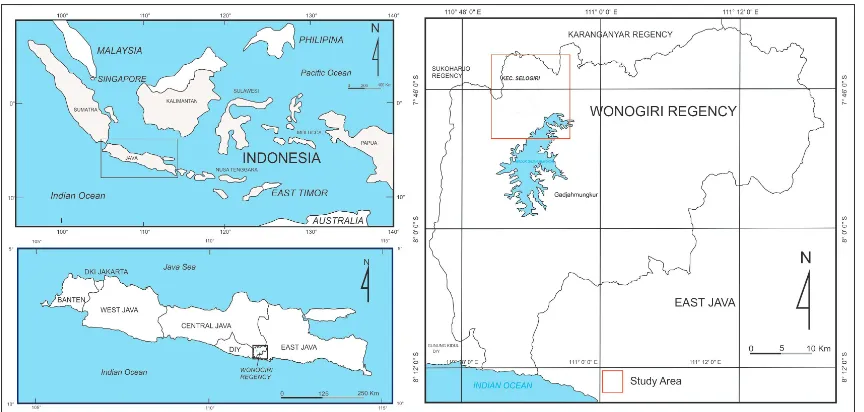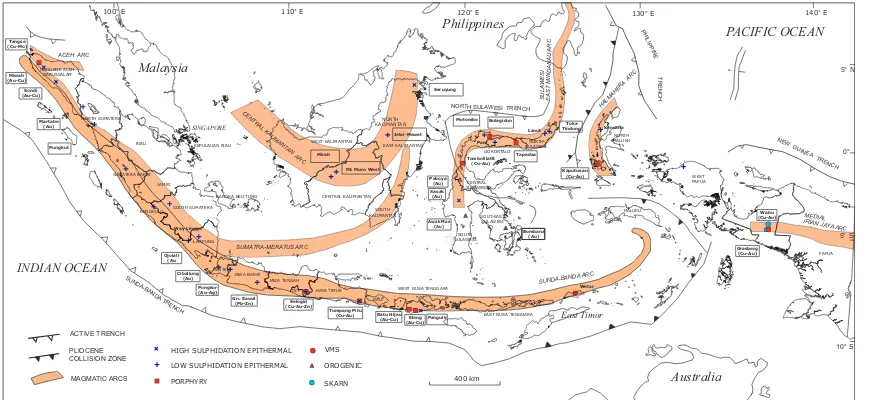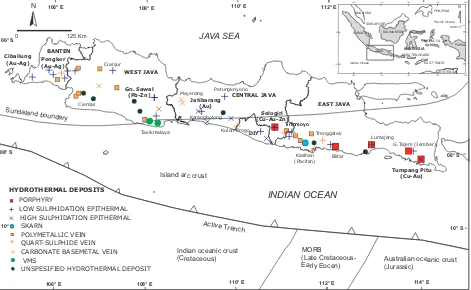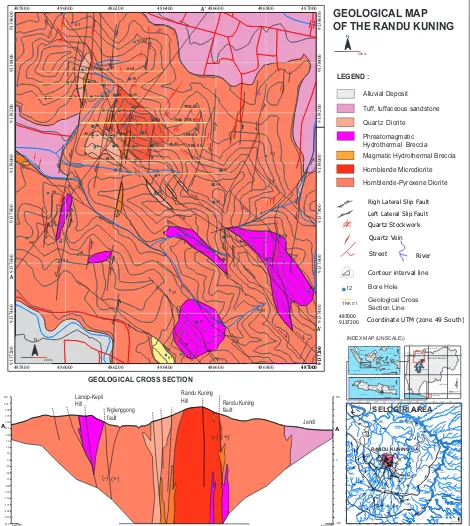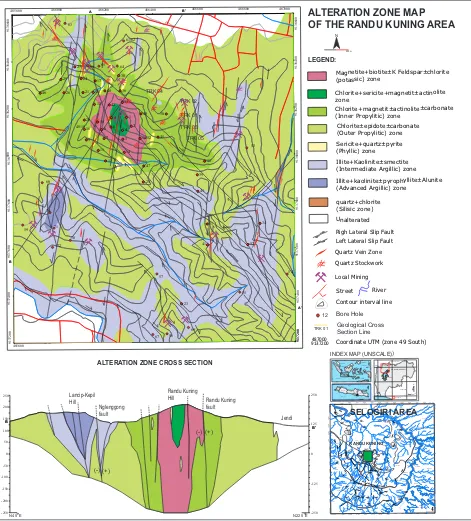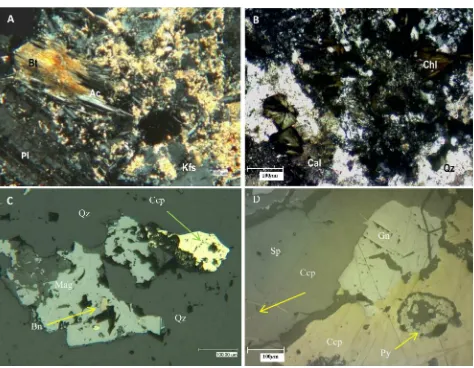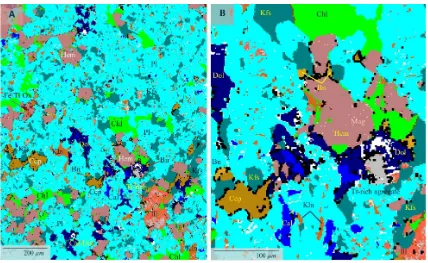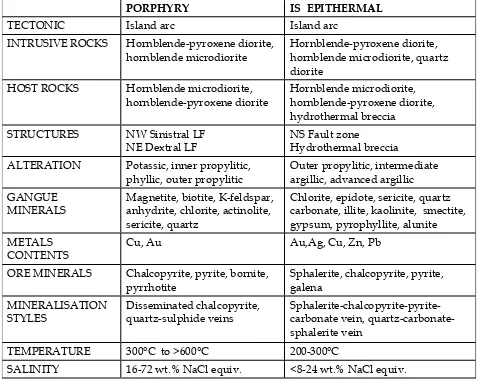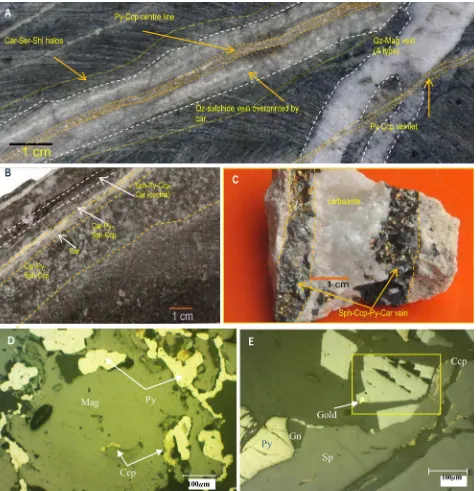Hydrothermal Alteration and Mineralization of the Randu Kuning
Porphyry Cu-Au and Intermediate Sulphidation Epithermal Au-Base
Metals Deposits in Selogiri, Central Java, Indonesia
Sutarto*1,2, Arifudin Idrus2, Agung Harijoko2, Lucas Donny Setijadji2, Franz Michael
Meyer3, Sven Sindern3, and Sapto Putranto4
1Universitas Pembangunan Nasional "Veteran", Yogyakarta, Indonesia 2Universitas Gadjah Mada, Yogyakarta, Indonesia
3RWTH Aachen University, Germany 4PT. Alexis Perdana Mineral
ABSTRACT. The Randu Kuning Porphyry Cu-Au prospect area is situated in the Selo-giri district, WonoSelo-giri regency, Central Java, Indonesia, about 40 km to the South-East from Solo city, or approximately 70 km east of Yogyakarta city. The Randu Kuning area and its vicinity is a part of the East Java Southern Mountain Zone, mostly occupied by both plutonic and volcanic igneous rocks, volcaniclastic, silisiclastic and carbonate rocks. Magmatism-volcanism products were indicated by the abundant of igneous and volcani-clastic rocks of Mandalika and Semilir Formation. The Alteration zones distribution are generally controlled by the NE–SW and NW–SE trending structures. At least eight types of hydrothermal alteration at the Randu Kuning area and its vicinity had been identified, i.e. magnetite + biotite ± K-feldspar ± chlorite (potassic), chlorite + sericite + magnetite ± actinolite, chlorite + magnetite ± actinolite ± carbonate (inner propylitic), chlorite + epidote ± carbonate (outer propylitic), sericite + quartz + pyrite (phyllic), illite + kaoli-nite ± smectite (intermediate argillic), illite + kaolikaoli-nite ± pyrophyllite ± alukaoli-nite (advanced argillic) and quatz + chlorite (sillisic) zones. The Randu Kuning mineralization at Sel-ogiri is co-existing with the porphyry Cu-Au and intermediate sulphidation epithermal Au-base metals. Mineralization in the porphyry environment is mostly associated with the present of quartz-sulphides veins including AB, C, carbonate-sulphides veins (D vein) as well as disseminated sulphides. While in the epithermal prospect, mineralization is particularly associated with pyrite + sphalerite + chalcopyrite + carbonate ± galena veins as well as hydrothermal breccias. The Randu Kuning porphyry prospect has copper gold grade in range at about 0.66–5.7 gr/t Au and 0.04–1.24 % Cu, whereas in the intermediate sulphidation epithermal contain around 0.1–20.8 gr/t Au, 1.2–28.1 gr/t Ag, 0.05–0.9 % Zn, 0.14–0.59 % Pb and 0.01–0.65 % Cu.
Keywords: Hydrothermal alteration·Mineralization·Porphyry·Epithermal.
1 INTRODUCTION
The Randu Kuning Porphyry Cu-Au prospect area is situated in Selogiri, Wonogiri, Central Java Province, Indonesia at the coordinate UTM 485800-48700 mE and 9137200-9138600 mS (49
*Corresponding author: SUTARTO, Department of Geological Engineering, UPN "Veteran" Yogyakarta, JL. SWK. 104 Condongcatur, Yogyakarta, E-mail: [email protected]
South zone) within the mining exploration con-cession (IUP) of PT Alexis Perdana Mineral (Figure 1). . This location is reachable with four wheel or two wheel vehicle, about 40 km to the south-east from Solo city, or approximately 70 km east of Yogyakarta city.
Figure 1: Location map of Selogiri area, Wonogiri. era (1929–1935), and by reference of this
ex-ploration, then were followed by the Japanese during the occupation of Indonesia (1942–1954) (Isnawanet al., 2002). The production recorded from this mine is in small amounts and could be exported to Japan (van Bemmelen, 1949). 13 years after independence, in 1958, the In-donesian government evaluated the existing hydrothermal ore deposits in Tirtomoyo, which stated that there were three abundant out-crops of quartz veins containing chalcopyrite (Isnawan et al., 2002). Since 1995, the Randu Kuning prospect area attracted the attention of university students when illegal gold mining activity started in the area (Suasta and Sin-ugroho, 2011). May 2009, PT. Alexis Perdana Mineral the owner of the IUP in Selogiri, started exploration particularly on the Randu Kuning and others several prospects surrounding.
The Mineralisation type of Randu Kuning prospect was interpreted by many researchers as a porphyry Cu-Au ore deposit and a num-ber gold-base metals epithermal deposits in its surroundings (Imaiet al., 2007; Suasta and Sin-ugroho, 2011; Corbett, 2011, 2012 and Muthi
et al., 2012). The intensive erosion process
has uncovered the upper parts of the porphyry deposit, whereas several gold-base metal ep-ithermals are preserved along adjacent ridge (Suasta and Sinugroho, 2011). Many epithermal veins were also found and crosscut into deeply porphyry veins and related potassic alteration (Suasta and Sinugroho, 2011; Corbett, 2012).
2 RESEARCH METHODS
In this study, veins and rocks samples were collected systematically from both drilling and local mining tunnels as well as surface out-crops. Secondary minerals assemblages were identified from polarisation microscopic obser-vation (120 samples), X-ray diffractometer (43 samples), Qemscan(Quantitative Evaluation of Minerals by Scanning Electron Microscopy) analysis (4 samples). The X-ray diffractometer was conducted at the Geological Engineering Department of Gadjah Mada University us-ing Rigaku RINT-2100. Petrographic and ore microscopic analyses were carried out at the Geological Engineering Department of Gadjah Mada University and the Department of Min-eralogy and Economic Geology, RWTH Aachen University, Germany. QemScan analyses were carried out at the Department of Mineralogy and Economic Geology, RWTH Aachen Univer-sity, Germany.
3 GEOLOGICSETTINGS
Regional geology
Indonesian achipelagos are controlled by mag-matic arcs, vary in age from Late Mesozoic through the Cenozoic. Most mineralizations are derived from five major Tertiary arcs in-cluding the Sunda-Banda, Central Kalimantan, Sulawesi-East Mindanau, Halmahera and Me-dial Irian Jaya (Carlile and Mitchell, 1994) (Fig-ure 2).
extend-MAGMATIC ARCS
LOW SULPHIDATION EPITHERMAL
PORPHYRY 400 km
INDIAN OCEAN NANGROE ACEH
DARUSSALAM
NORTH SUMATERA
SUMATERA BARAT
RIAU KEPULAUAN RIAU
JAMBI
BENGKULU SOUTH SUMATERA
BANGKA BELITUNG
LAMPUNG
WEST KALIMANTAN
CENTRAL KALIMANTAN
SOUTH KALIMANTAN
EAST KALIMANTAN
BANTEN JAWA BARAT
JAWA TENGAH
DIY JAWA TIMUR
BALI
WEST NUSA TENGGARA
EAST NUSA TENGGARA SOUTH
NEW GUINEA
TRENCH
NORTH SULAWESI TRENCH
PHILIPPINE
COLLISION ZONE HIGH SULPHIDATION EPITHERMAL
NORTH KALIMANTAN
SUNDA-BANDA ARC
SUMATRA-MERATUS ARC IRIAN JAYA ARC
ACEH ARC
SULA
WESI
EAST MINDANAU
ARC
Mt. Muro West
Toka
Figure 2: Magmatic arcs distributing in Indonesia (redraw after Carlile and Mitchell, 1994) and different styles of mineral deposits in Indonesia (Carlile and Mitchell, 1994, Setijadji and Maryono, 2012).
ing from Sumatra through Java to the east of Damar island, where many ore deposits have been known (van Leeuwen, 1994; Charlile and Mitchell, 1994) (Figure 2). The arc is the longest arc in Indonesia, developed by northwards subduction of the Indian-Australian oceanic plate beneath the southeastern margin of the Eurasian continental plate, named the Sunda-land (Hamilton, 1979; Katili, 1989). The west-ern segment of the arc has an abundance of low sulphidation epithernal vein system such as mineralization in Miwah, Sondi, Martabe, Way Linggo, Ojo Lali, Cibaliung, Pongkor and Banyumas. A marked change in the mineraliza-tion style is seen in the eastern arc segment, in which many porphyry copper-gold mineraliza-tions were found (Charlile and Mitchell, 1994), such as in Batu Hijau, Elang, Tumpang Pitu (Hellman, 2010; Maryonoet al., 2012) and Sel-ogiri (Muthiet al., 2012).
Geology and mineralization in Java
Soeria-atmadja et al., (1994) divided the Ter-tiary magmatism on Java into two periods, i.e. the Late Eocene-Early Miocene and the Late Miocene-Pliocene magmatism. The vol-canic rocks of Late Eocene-Early Miocene mag-matism are widespread alongside the south-ern part of Java, which usually has tholeitic affinity, while the Late Miocene-Pliocene mag-matism has tholeitic, calc alkaline to high K calc alkaline series, distributed mostly
north-ward from the Late Eocene-Early Miocene mag-matism. Many Eocene-Early Miocene volcanic rocks have been identified and observed in few areas especially in the Southern Mountain of Java island, including Cikotok Formation (Bayah dome) and Jatibarang Volcanic Forma-tion in West Java, dioritic and diabasic intrusive rocks in Karangsambung Central Java and an-desite intrusion (Besole Formation) Pacitan East Java. Whereas many Late Miocene volcanic rocks have also observed such as in Karangko-bar Banjarnegara, Cilacap-Pangandaran, Paci-tan and Selogiri (Soeria-atmadjaet al., 1994).
set-ting, on the other hand, Eastern Java to Sum-bawa is dominated by a porphyry-related Cu-Au mineralisation system associated with low to moderate K, minimum crustal contamination Middle Tertiary--Neogen magmatism (Setijadji and Maryono, 2012).
The Pongkor epithermal Au-Ag deposit which has reserves of more than 98 tonnes Au and 1026 tonnes Ag (Milésiet al., 1999), up to now is the largest Au-Ag mining in Java. Most epithermal Au-Ag mineralizations are hosted within volcanic rocks, except those which were found in Cikotok West Java and Karangsambung, Central Java, indicating a sediment hosted and a metamorphic hosted respectively. Many porphyry Cu-Au mineral-ization are also reported in some places, such as Tumpang Pitu prospect in Banyuwangi (Hell-man, 2010), Kali Sanen prospect in Jember (Tain
et al., 2005), Tempungsari prospect in Lumajang
(Tain et al., 2005), Randu Kuning prospect in Wonogiri (Prihatmoko et al., 2002; Imai et al., 2007; Suasta and Sinugroho, 2011; and Muthi
et al., 2012).,) Trenggalek, and Ciemas prospect
(Tainet al., 2005). The Randu Kuning Porphyry Cu-Au, Wonogiri and the Tumpang Pitu Por-phyry Cu-Au±Mo, Banyuwangi are the most promising prospects of porphyry type deposits on Java island.
Geology of the Randu Kuning Area
The Randu Kuning area is situated in the area where porphyry Cu-Au and epithermal Au low sulphidation occured, at the center of the Sel-ogiri area. The area is occupied by dioritic intrusive rocks and hydrothermal breccias as well as many types of veins/veinlets. Intru-sive rocks consist of hornblende-pyroxene ite, hornblende microdiorite and quartz dior-ite, while the hydrothermal breccia can be clas-sified as magmatic hydrothermal berccia and phreatomagmatic breccia (Figure 4). Based on the observation both on the surface outcrops and drilling core samples, the intrusive rocks at the study area consist of hornblende-pyroxene diorite (previous researcher called as medium diorite), hornblende microdiorite and quartz diorite.
The Hornblende-pyroxene diorite which is not associated with the ore mineralization (pre-mineralisation), occured prior to the microdi-orite formation which is responsible for
Cu-Au porphyry mineralization in the Selogiri area (syn-mineralisation). Previous researchers de-scribed this intrusive rock as hornblende diorite (Suasta and Sinugroho, 2011) and medium dior-ite (Muthiet al., 2012). On the surface outcrops, it mostly shows weathered conditions, but in some locations, especially in river walls, the py-roxene diorite is still relatively fresh. Generally it shows a gray colour in fresh condition (lighter than hornblende microdiorite), porphyritic tex-ture (moderate-strong), having medium crystal size (0.3–2 mm) with pyroxene and hornblende phenocrys size varies up to 2 cm. It contains a high proportion of plagioclase or at about 35--50 percent with a lesser amount of hornblende and pyroxene (3–8 %) (Sutartoet al., 2015b).
The hornblende microdiorite is characterized by fine grained phenocrysts size (0.1–1 mm), many of samples which are microscopically classified as andesite (porphyritic texture), commonly consist of about 30–45 percent of plagioclase and 5–14 percent of hornblende. The hornblende microdiorite is believed to be responsible for the extensive alteration and Cu-Au porphyry ore deposit in the study area. Physically, it appears darker in colour and finer in crystals size than hornblende-pyroxene dior-ite. It is caused not only by the amount of mafic but also due to the abundance of the secondary magnetite. Most of the hornblende microdior-ite intrusive body altered to potassic zone and lack of prophyllitic and phyllic alteration types. The contact between hornblende microdiorite and hornblende-pyroxene diorite is commonly characterized by the formation of intrusive contact with breccia (magmatic hydrothermal breccia). The peak part of the Randu Kuning hill is a representative of this type of intrusion (Sutartoet al., 2015b).
08° S
CENTRAL JAVA
EAST JAVA
Indian oceanic crust
(Cretaceous) (Late Cretaceous-MORB
Early Eocen) Australian oceanic crust(Jurassic)
JAVA
110° 120° 130° 140° 100°
110° 120° 130° 140° 100°
SUMATRA KALIMANTAN SULAWESI
PAPUA
UNSPESIFIED HYDROTHERMAL DEPOSIT VMS POLYMETALLIC VEIN
QUART-SULPHIDE VEIN CARBONATE BASEMETAL VEIN PORPHYRY
LOW SULPHIDATION EPITHERMAL HIGH SULPHIDATION EPITHERMAL HYDROTHERMAL DEPOSITS
Island arc crust
Lumajang
Figure 3: The different styles of mineral deposits distribution in Java island (Modified from Seti-awan and Yudawinata, 200; Setijadjiet al., 2006; Setijadji and Maryono, 2012). Basement crusts is from Setijadjiet al.(2006); Setijadji and Maryono (2012).
mineralization. The dimensions and the dis-tribution of this intrusion is relatively nar-rower and smaller than those of hornblende-pyroxene diorite and hornblende microdiorite intrusions (Sutarto et al., 2015b). There are at least two types of hydrothermal breccia recognized in the research, i.e., magmatic-hydrothermal breccias and phreatomagmatic breccias, which were found in the Randu Kun-ing hill area. Magmatic-hydrothermal breccias in the research area are characterized by var-ious irregular bodies showing subvertical to vertical shapes in contact with the wall rocks, fragments mostly monomic, i.e. various al-tered diorite, angular-subrounded and larger in grain size (0.5–8.4 cm), matrix mostly con-sisting of hydrothermal minerals (magnetite, chalcopyrite and pyrite) as open spce infilling, fragmment/matrix ratio is high (60–90 vol.%) or predominantly fragment supported, tex-ture/structures usually crackel, jig-saw and rotated fragments, no fluidization (Sutarto et al., 2015b). Phreatomagmatic breccias exhib-ite, irregular dyke and pipe body, subvetical-vertical, fragments/clasts consist of
polim-ictic components including juvenil (mostly rounded) and various wall rock such as altered diorites, veins/veinlets, sandstone, quartzite, conglomerate and schist (mostly subangular), 0.2–4.5 cm in size, low fragment/matrix ratio (10–65 vol.%). These breccia commonly show fluidization, associated with potassic, prophyl-litic and argillic alteration type, mineralisation occured in both dessimination and open space infilling (Sutartoet al., 2015b).
Hornblende Microdiorite Hornblende-Pyroxene Diorite Quartz Diorite
Magmatic Hydrothermal Breccia Phreatomagmatic
Hydrothermal Breccia Tuff, tuffaceous sandstone Alluvial Deposit
Left Lateral Slip Fault
River Street
487000
9137200 Coordinate UTM (zone 49 South)
Contour interval line Quartz Vein
Geological Cross Section Line Bore Hole
12
TRK 01
Quartz Stockwork Righ Lateral Slip Fault LEGEND :
GEOLOGICAL MAP OF THE RANDU KUNING
0
Randu Kuning Hill Lancip-Kepil
Hill
Jendi Randu Kuning
fault
485800 486200 486400 486600 486800 487000
486000
485800 486200 486400 486600 486800 487000
9137200
GEOLOGICAL CROSS SECTION
INDEX MAP (UNSCALE))
JAVA
110° 120° 130° 140° 100°
110° 120° 130° 140° 100°
WADUK GAJAH MUNGKUR
110° 48' 0" E 111° 0' 0" E 111° 12' 0" E
105° 110° 115°
105° 110° 115° 5°
483000 485000 487000 489000 491000 493000 07 52'00"S 483000 484000 485000 486000 487000 488000 489000 490000 491000 492000 493000 494000
9143000
Kec. WURYANTORO Kec. NGUNTORONADI Kec. BULU
07 52'00" S
07 44'15" S
types were controlled by sinistral (left) lateral-slip faults (Sutartoet al., 2015b).
4 HYDROTHERMAL ALTERATION AND MIN -ERALIZATION
Alteration types
Alteration zones distributions of the researched area are generally controlled by the NE–SW and NW--SE trending structure. At least eight types of hydrothermal alteration at the Randu Kun-ing area and its vicinity had been identified, i.e., 1) Magnetite + biotite ± K-feldspar ± chlorite (potassic); 2) Chlorite + sericite + magnetite ± actinolite; 3) Chlorite + magnetite ± actinolite ± carbonate (inner propylitic); 4) Chlorite + epi-dote ± carbonate (outer propylitic); 5) Sericite + quartz + pyrite (phyllic); 6) Illite + kaolinite ± smectite (intermediate argillic); 7) Illite + kaoli-nite ± pyrophyllite ± alukaoli-nite (advanced argillic) and 8) Quatz + chlorite (sillisic) zones Figure 5. The magnetite + biotite ± K-feldspar ± chlo-rite (potassic) zone is scattered on microdiochlo-rite intrusive rocks body and small part of pyrox-ene diorite intrusive rocks especially in contact to the microdiorite intrusion of Randu Kuning hill. This zone is characterized by the present of secondary minerals assemblage, i.e., one or both of secondary biotite and/or K-feldspar associated with magnetite, actinolite, quartz and lack of carbonate minerals (Suasta and Sin-ugroho, 2011; Corbett, 2011, 2012 and Muthi
et al., 2012). Microscopically, biotite usually
has dark-brown colour, fine grained, fibrous Figure 6A and is present predominantly in the central part of the hornblende microdior-ite intrusion and gradually will decrease to the edge part of the hornblende microdiorite and the part of pyroxene-hornblende diorite. The Qemscan analysis of the potassic-altered hornblende-pyroxene diorite (sample WDD 03-47.20), shows many kinds of hydrothermal secondary minerals such as biotites, alkali-feldspars, chlorites, quartzes, calcites, kaolin-ites, illkaolin-ites, sericite and rare of ore minerals (pyrite-pyrrhotite-chalcopyrites) Figure 7.
The chlorite + sericite + magnetite ± actino-lite is widespread on the upper part of the mag-netite + biotite ± K-feldspar ± chlorite (potas-sic) characterized by the dominant of chlorite and sericite, although other secondary mineals such as magnetite, quartz, and sometimes
acti-nolite are still found. The chlorite + sericite + magnetit ± actinolite zone is developed on the small upper part of hornblende microdior-ite. The chlorite + magnetite ± actinolite ± car-bonate alteration type Figure 6B is commonly recognised between magnetite + biotite ± K-feldspar ± chlorite (potassic) zone and chlorite + epidote ± carbonate (outer propylitic) zone. The zone mostly is widespread in pyroxene-hornblende diorite rocks, and within a small part of hornblende microdiorite. In some places these alteration zones cut to minerals assem-blage of the magnetite + biotite ± K-feldspar ± chlorite (potassic) zone and gradually changed outward to the chlorite + epidote ± carbonate (outer propylitic) zone. The chlorite + epidote ± carbonate, (outer propylitic) alteration zone is widespread on pyroxene-hornblende diorite rocks and a small part of quartz diorite, gradu-ally from the inner prophyllitic to least altered rock, comprising of chlorites, epidotes, carbon-ates and quartz.
assem-N
485800 486200 486400 486600 486800 487000
9138000 (Inner Propylitic) zone
Chlorite±epidote±carbonate (Outer Propylitic) zone Sericite+quartz±pyrite (Phyllic) zone Illite+Kaolinite±smectite (Intermediate Argillic) zone
quartz+chlorite (Silisic zone)
Illite+kaolinite±pyrophyllite±Alunite (Advanced Argillic) zone
Unalterated
Chlorite+sericite+magnetit±actinolite zone
Left Lateral Slip Fault
River Street
487000
9137200 Coordinate UTM (zone 49 South)
Contour interval line Quartz Vein Zone
Geological Cross Section Line Bore Hole
12
TRK 01
Quartz Stockwork Righ Lateral Slip Fault
Local Mining
Randu Kuning Hill Lancip-Kepil
Hill
Jendi Randu Kuning
fault
INDEX MAP (UNSCALE))
JAVA
110° 120° 130° 140°
100°
110° 120° 130° 140°
100°
WADUK GAJAH MUNGKUR
110° 48' 0" E 111° 0' 0" E 111° 12' 0" E
105° 110° 115°
105° 110° 115°
5°
483000 485000 487000 489000 491000 493000 07 52'00"S
483000 484000 485000 486000 487000 488000 489000 490000 491000 492000 493000 494000
9143000
Kec. WURYANTORO Kec. NGUNTORONADI Kec. BULU
07 52'00" S
07 44'15" S ALTERATION ZONE MAP OF THE RANDU KUNING AREA
N
200 m
ALTERATION ZONE CROSS SECTION
LEGEND:
Figure 7: Qemscan image of A). The magnetite+biotite±K-feldspar±chlorite (potassic)-altered hornblende-pyroxene diorite, consist of many secondary minerals such as K-feldspar-biotite-magnetite-hematite were replaced by chalcopyrite-bornite-chlorite, quartz-calcite-dolomite and kaolinite-illite assemblages. B). Closed up the image of figure A. Sample WDD 03-47.20). Min-eral abbreviations: Bn = Bornite, Bt = biotite, Qz = quartz, Chl = chlorite, Ccp = chalcopyrite, Dol = dolomite, Hem = hematite, Kfs = K-feldspar, Kln = kaolinite, Mag = magnetite, Pl = plagioclase Ill = illite.
blages, which is mostly limited to fault zones or selvages to late stage quartz-pyrite veins or D veins (Corbett, 2012).
Mineralization
Based on the characteristics of many param-eters such as pattern and type of hydrother-mal alteration, veins type, gangue and ore min-erals assemblages, fluid inclusions, the Randu Kuning mineralization at Selogiri is likely por-phyry Cu-Au to intermediate sulphidation ep-ithermal Au-base metals (Table 1. There are at least eight mineralisation prospects areas at the Randu Kuning and its vicinity, they are Randu Kuning porphyry Cu-Au prospect and many intermediate sulphidation epithermal Au-base metals prospects including Bukit Piti-Tumbu, Gawe, Geblak, Jangglengan, Lancip-Kepil and Randu Kuning South prospects (Table 2). Most mineralizations in the researched area are as-sociated with the present of some sulphides such as chalcopyrite, pyrite, pyrrhotite, bornite, sphalerite, galena, and chalcocite. The copper gold resource of the Randu Kuning porphyry
prospect comprises 90.9 Mt at 0.35 g/t Au and 0.10 % Cu, using a cut-off grade of 0.2 g/t AuEq (Nightingale, 2014).
Porphyry Cu-Au mineralization
Table 1: Characteristic of the porphyry Cu-Au and epithermal Au deposits in the Randu Kuning area.
PORPHYRY IS EPITHERMAL
TECTONIC Island arc Island arc
INTRUSIVE ROCKS Hornblende-pyroxene diorite,
hornblende microdiorite
Hornblende-pyroxene diorite, hornblende microdiorite, quartz diorite
HOST ROCKS Hornblende microdiorite,
hornblende-pyroxene diorite
Hornblende microdiorite, hornblende-pyroxene diorite, hydrothermal breccia
STRUCTURES NW Sinistral LF
NE Dextral LF
NS Fault zone
Hydrothermal breccia
ALTERATION Potassic, inner propylitic,
phyllic, outer propylitic
Outer propylitic, intermediate argillic, advanced argillic GANGUE
MINERALS
Magnetite, biotite, K-feldspar, anhydrite, chlorite, actinolite, sericite, quartz
Chlorite, epidote, sericite, quartz carbonate, illite, kaolinite, smectite, gypsum, pyrophyllite, alunite METALS
CONTENTS
Cu, Au Au,Ag, Cu, Zn, Pb
ORE MINERALS Chalcopyrite, pyrite, bornite,
pyrrhotite
Sphalerite, chalcopyrite, pyrite, galena
MINERALISATION STYLES
Disseminated chalcopyrite, quartz-sulphide veins
Sphalerite-chalcopyrite-pyrite-carbonate vein, quartz-Sphalerite-chalcopyrite-pyrite-carbonate- quartz-carbonate-sphalerite vein
TEMPERATURE 300°C to >600°C 200-300°C
S
Randu Kuning Prospect
Randu Kuning South Prospect
Gawe
STRUCTURES NW sinistral fault NE dextral LF
Dextral fault EW vein
Dextral fault EW vein
Fault zone Fault zone Fault zone
Hydrothermal breccia
Fault zone Contact dia-treme breccia
ALTERATION Potassic, inner propylitic, phyllic
Phyllic, argillic, silisic
Propylitic, intermediate argillic
GANGUE MINERALS Bt, Mag, Kfs, Ac, Anh, Qz, Chl, Ep Chl, Ill, Kln, Ill-Sme, Gyp, Alu Mgs, Ill, Ill-Sme
METAL CONTENTS Cu+Au 0.66-5.7 g/t Au 0.003-0.37% Zn 00089-0.14% Pb
Au+Cu 0.1-6.97g/t Au 0.05-0.25%Zn
Stockwork Qz Disseminated Ccp Sul+Qz vein (porphyry vein types)
Py+Cal+Qz±Ccp veins
Py+Cal+Qz±Ccp ± Sph veins
Qz-Car vein Py+Car+Qz cut C and B types Dess Py-Ccp
Dissseminated Py+Ccp+Sph Qz+Car+Py± Sph±Ccp vein Ep±Chl vein
Qz+Car+py±Sph ±Ccp±Gn vein
Disseminated Sph
Qz+Py+Car Ep±red Sph vein
ORE DEPOSIT STYLE Porphyry Cu-Au IS epithermal Au cut main porphyry
IS Epithermal Au cut extension porphyry
IS Epithermal Au cut peripheral porphyry
IS epithermal Au cut extension porphyry
IS epithermal Au cut peripheral porphyry
IS epithermal Qz-sulphide Au Car-base metal Au
Abbreviations: MD = hornblende microdioorite, MED = hornblende-pyroxene diorite, CD = quartz diorite, An = anhydrite Bt = biotite, Bn = bornite, Ccp = chalcopyrite, Py = pyrite, Gn = galena, Sph = sphalerite, Pyrr = pyrrhothite, Cc = chalcocite, Ac = actinolite, Kfs = K-feldspar, Qz = quartz, Mag =
magnetite, Chl = chlorite, Ser = sericite, Cal = calcite. 12
102 g/t Au; 1080 ppm Cu and in WDD8-148.3m contains 1.74 g/t Au; 2550 ppm Cu.
Copper and gold are likely to be transported together as chloride complexes (CuCl0 and
AuCl−
2) in magnetite stability field. The chlorite
complexes then react with existing magnetite to produce free gold and chalcopyrite (Equa-tion 1). Many of replacement ore texture, show many chalcopyrite replacing magnetite and minor bornite associated with gold mineraliza-tion.
Fe3O4+6H2S+AuCl−2 +3CuCl0+7/2H2O
↔4Au0+3CuFeS2+7H++11Cl−+7/4O2
(1) Hence, the Randu Kuning porphyry Cu-Au deposit is chalcopyrite- rich ore rather than bornite- rich ore. Arif and Baker (2004) sug-gested that porphyry Cu-Au deposits with chalcopyrite-rich ores are more likely to have a higher proportion of free gold and different with those of bornite-rich ores, where gold mostly occurred within copper sulphide grains as an invisible gold within the sulphide struc-ture.The gold and copper grade in the Randu Kuning are mostly associated with the presence of chalcopyrite both in quartz-sulphides veins and or as a replacement in magnetite grains (Figure 8D).
Epithermal environment
On the other hand, the epithermal environ-ment, gold and copper usually are transported in different ion complexes. Au is transported as the thio complexe [Au(HS)−
2; Au2(HS)2S2
−
and HAu(HS)−
2] in phyrite stability field, while Cu
is preferably transported as chloride complex in the hematite stability field (Equation 3–4).
4Au(HS)−
2 +2H2O+4H+
↔a Au0+8H2S+O2 (2)
2CuCl0+Fe2O3+4SO−4 +6H+
↔2CuFeS2+2Cl−+H2O+8O2 (3)
ZnCl+H2S↔ZnS+2H++Cl− (4)
In the Randu Kuning epithermal propects, gold and base metals mineralization are mostly associated with sulphides + quartz + carbon-ate veins and hydrothermal breccias (Figure
8B,C). Many sulphides such as pyrite, chal-copyrite, sphalerite and lack of galena within open space hydrothermal breccia also have an important role in gold-silver-zinc-lead miner-alization, particularly in the epithermal en-vironment. Brecciated pyrite-carbonate vein in Geblag (WDD 54 depth 167-169 m) con-tains 0.63–2.229 ppm Au, 28.1–31.4 ppm Ag, 784–1150 ppm As, 0,45–0.65 % Cu, 301–640 ppm Pb and 0.054–0.57 % Zn. Hydrothermal breccia at the Jangglengan prospect has an important role in Au-Zn-Ag mineralization. Drilling core samples of WDD 69 depth 70–76 m comprising 0.3–1.08 ppm Au, 1–1.4 ppm Ag, 33–195 ppm Pb, 182–2010 ppm Zn and 13–56 ppm As. In the Figure 8E, free gold grain is found in an inclu-sion within galena, in sphalerite-galena-pyrite-chalcopyrite-carbonate vein.
Paragenetic sequences
Based on the veins/veinlets observation data both field outrops and drilling cores indicate that there are two ore mineralizing systems in the Randu Kuning hills those are porphyry Cu-Au system and intermediate sulphidation ep-ithermal Au-base metals system (Figure 9).
Hydrothermal fluids which responsible for the porphyry Cu-Au mineralization is associ-ated with the occurence of the horblende mi-crodiorite intrusion. The first ore mineraliza-tion is a Cu-Au porphyry type deposit charac-terized by the domination of potassic (biotite + K-feldspar + magnetite+ quartz minerals as-semblage) and propylitic alteration and small volume of phyllic and advanced argillic alter-ation within fault zone asssociated with the for-mation of several porphyry veins style, i.e.:
Stage 1: Early porphyry veining and brecciation
a. Magnetite ± chalcopyrite ± quartz ± biotite veinlets.
b. Magmatic Hydrothermal breccia. c. Quartz ± magnetite (A type) vein.
d. Banded magntetite-quartz (M type) vein. e. Quartz ± K-feldspar ± magnetite ± pyrite
(B type) vein
Stage 2: Midle porphyry veining and brecciation
PORPHYRY STAGES EPITHERMAL STAGE OX
VEIN TYPES EM Bx A M B Bx AB C D R Bx 1 2 3 Bx 4 5 6 7
STAGE 1 STAGE 2 STAGE 3 STAGE 4
ALTERATION ZONES
HYDROTHERMAL MINERAL ASSEMBLAGES
Potassic In.propylitic Out.propylitic Phyllic Chl-Ser-Mag Argillic Adv. Argillic Silisic Biotite K-feldspar Quartz Actinolite Chlorite Epidote Anhydrite Calcite Dolomite Gypsum Magnetite Pyrite Chalcopyrite Bornite Sphalerite Galena Pyrrhotite Covellite Digenite Chalcocite Hematite Sericite Illite Smectite Illite-Smectite Pyrophyllite Kaolinite Alunite Malachite
Explanation:
A : A vein type M : M vein type B : B vein type
AB : AB vein type EM : Early magnetite-mica C : C vein type
R : Replacement Bx : Brecciation D : D vein type
OX : Oxidation
1,2,3,4,5,6,7: Ephithermal vein stages
b. Quartz ± pyrite ± chalcopyrite ± bornite (AB type) vein.
c. Pyrite ± chalcopyrite (C type) veinlet.
Stage 3: Late porphyry veining
a. Pyrite + quartz ± chalcopyrire ± carbonate (D type) vein.
b. Sericite-chlorite-silica selvages.
While the second ore mineralization is an inter-mediate sulphidation epithermal Au-base met-als mineralization which overprint earlier por-phyry mineralization stage characterising by the formation of the outer propylitic and argillic alteration type as well as the formation of later epithermal vein types. Magmatism that pro-duced both hornblende microdiorite and quartz diorite intrusions may be related and responsi-ble to the intermediate sulphidation epithermal mineralization.
Stage 4: Epithermal veining and brecciation
a. Phreatomagmatic breccia.
b. Epidote + chlorite ± quartz ± carbonate ± pyrite vein.
c. Sphalerite + chalcopyrite ± pyrite ± quartz vein.
d. Chalcopyrite + pyrite + quartz ± sphalerite ± chlorite vein.
e. Pyrite + quartz + carbonate ± chalcopyrite vein (carbonate as centre line or infill in the centre part of vein).
f. Brecciation.
g. Quartz + carbonate ± pyrite vein.
h. Quartz + carbonate ± pyrite ± chalcopyrite vein.
i. Carbonate ± gypsum vein. 5 CONCLUSIONS
Based on the characteristics of many parame-ters such as pattern and type of hydrothermal alterations, vein types, gangue and ore min-erals assemblages as well as fluid inclusions data, the Randu Kuning mineralization at Sel-ogiri is co-existing between porphyry Cu-Au and intermediate sulphidation epithermal Au-base metals deposits. Porphyry environment was developed at 300 to >600°C with salinity
ranges from 16–72 wt.% NaCl equiv., while in-termediate sulphidation epithermal occurred at 200–300°C with salinity about <8–24 wt.% NaCl equiv.
A dioritic composition range of the intrusive rocks type and the domination of the potas-sic and propylitic zones also lack the phyllic alteration type, suggested that the alteration model of the Cu-Au porphyry ore deposit in the Randu Kuning area is more typically a diorite model rather than a common quartz monzonite model.
Not all porphyry vein types contribute in copper and gold mineralization. In the por-phyry environment, the early quartz-magnetite veins (particularly A and M veins) generally do not contain Cu-Au or barren, while the later sulphide are bearing veins (AB, C , D veins as well as chalcopyrite dessiminated) mostly are rich of copper and gold, with copper and gold grade ranges about 0.66–5.7 gr/t Au and 0.04–1.24 % Cu. In the intermediate epithermal, gold and base metals mineralization mostly associated with sulphides + quartz + carbonate veins and have metals content grade ranges 0.1–20.8 gr/t Au, 1.2–28.1 gr/t Ag, 0.05–0.9 % Zn and 0.14–0.59 % Pb. Many sulphides such as pyrite, chalcopyrite, sphalerite and lack galena within open space hydrothermal breccia also have important role in gold-silver-zinc-lead mineralization.
The tonnage and grade copper and gold in the Randu Kuning area become much smaller and lower than those of other porphyry Cu-Au deposits in Eastern Sunda Arc, i.e., Tumpang Pitu porpyry Cu-Au at Banyuwangi East Java and Batu Hijau porphyry Cu-Au, Sumbawa. This may be due to the small-size of intru-sive rock (hornblende microdiorite) which is re-sponsible for the mineralization or because of a major eruption which is responsible for the for-mation of crater.
ACKNOWLEDGEMENTS
programs. My regards is extended to the man-agement of PT. Alexis Perdana Mineral, which has given us permission to do this research in the Selogiri prospect area and its vicinity. I also would like to thank the Head of the In-stitute of Mineralogy and Economic Geology (IML) of Aachen (RWTH) University, Germany who gave me permission to access to the labo-ratories.
REFERENCES
Arif, J., and Baker, T. (2004) Gold Paragenesis and Chemistry at Batu Hijau, Indonnesia: Implica-tions for Gold-Rich Porphyry Copper Deposits, Mineralium Deposita 39: 523-335.
Carlile, J.C. dan Mitchell, A.H.G. (1994) Magmatic Arcs and Associated Gold and Copper Mineral-isation in Indonesia, Journal of Geochemical Ex-ploration 50: 92-142.
Corbett, G. (2011) Comments on The Exploration Potential of The Wonogiri Porphyry Cu-Au Project, Central Java, Indonesia, Corbett Geo-logical Services Pty. Ltd., Unpublished, 27 p. Corbett, G. (2012) Further Comments on The
Wono-giri Porphyry Cu-Au Project Central Java, In-donesia, Corbett Geological Services Pty. Ltd., Unpublished, 37 p.
Hamilton,W.B. (1979) Tectonics of the Indonesian Region. Professional Paper 1078,U.S. Geolology Survey, Washington, DC.,345 p.
Hellman, P.L. (2010) Tujuh Bukit Project
Report on Mineral Resources, Located
in East Java, Indonesia. Technical
Re-port for Interprid Mines Limited. URL:
http://media.wotnews.com.au/esxann/01120-850.pdf.
Imai, A., Shinomiya, J., Soe, M.T., Setijadji, L.D., Watanabe, K., and Warmada, IW. (2007) Porphyry-Type Mineralization at Selogiri Area, Wonogiri Regency, Central Java, Indonesia, Re-sources Geology 57: 230-240.
Isnawan, D., Sukandarrumidi and Sudarno, I. (2002) Kontrol Struktur Geologi Terhadap Je-bakan Tembaga Sebagai Arahan Eksploitasi di Daerah Ngerjo dan Sekitarnya Kecamatan Tir-tomoyo, Kabupaten Wonogiri Propinsi Jawa Tengah, Gama Sains IV (2) Juli 2002, p. 149-157. Katili, J. A. (1989) Evolution of the Southeast Asian
arc complex, Geologi Indonesia 12: 113-143. Maryono, A. (2008) Porphyry Veining Types and
Characteristics, Porphyry Deposit Workshop, Batu Hijau December 1-5-2008.
Maryono, A., Setijadji, L.D., Arif, J., Harrison, R., Soeria-Atmadja, E. (2012) Gold, Silver and Cop-per Metallogeny of the Eastern Sunda Magmatic Arc Indonesia, Proceeding of Banda and Eastern
Sunda Arcs 2012 MGEI Annual Convention, 26-27 November 2012, Malang, East Java, Indonesia, p. 23-38.
Milési, J.P., Marcoux, E., Sitorus, T., Simanjun-tak, M., Leroy, J., and Bailly, L. (1999) Pongkor (West Java, Indonesia): A Pliocene Supergene-Enriched Epithermal Au-Ag-(Mn) Deposit, Min-eralium Deposita (1999) 34: 131-149.
Muthi, A., Basten, I.G., Suasta, I.G.M., and Litaay, N.E.W. (2012) Characteristic of Alteration and
Mineralization at Randu Kuning-Wonogiri
Project, Proceeding of Banda and Eastern Sunda Arcs 2012 MGEI Annual Convention, 26-27 November 2012, Malang, East Java, Indonesia, p. 117-132.
Nightingale, P.L. (2014) Report on Activities for the Quarter Ended 30 September 2014, Augur Re-sources Ltd. 11 p.
Prihatmoko, S., Digsowilogo, S., and Kusumanto, D. (2002) Potensi Cebakan Mineral di Propinsi Jawa Tengah dan Daerah Istimewa Yogyakarta, in: Sumberdaya Geologi Daerah Istimewa Yo-gyakarta dan Jawa Tengah, Ikatan Ahli Geologi Indonesia Pengurus Daerah DIY-Jateng, p. 87-103.
Setijadji, L.D., Kajino, S., Imai, A., and Watanabe, K. (2006) Cenozoic Island Arc Magmatism in Java Island (Sunda Arc, Indonesia): Clues on Rela-tionships between Geodynamics of Volcanic Cen-ters and Ore Mineralization, Resource Geology 56: 267-292.
Setijadji, L.D. and Maryono, A. (2012) Geology and Arc Magmatism of the Eastern Sunda Arc, Indonesia, Proceeding of Banda and Eastern Sunda Arcs 2012 MGEI Annual Convention, 26-27 November 2012, Malang, East Java, Indonesia, p.1-22.
Setiawan, B. dan Yudawinata, K. (2000) Review of Mineral Exploration Along the Sunda-Banda Magmatic Arc, Freeport-ITB Geological Sympo-sium, 13 p.
Suasta, IG.M. and Sinugroho, I.A. (2011) Occurrence of Zoned Epithermal to Porphyry Type Cu-Au Mineralization at Wonogiri, Central Java,
Pro-ceeding of The 36th HAGI and 40th IAGI Annual
Convention.
Soeria-Atmadja, R., Maury, R.C., Bellon, H., Pring-goprawiro, H., Polvé, M., and Priadi, B. (1991)
The Teriary Magmatic Belt in Java. The
Pro-ceeding of the Silver Jubbiles Symposium On the Dynamics of Subduction and Its Prod-ucts,Yogyakarta: p. 98-121.
Soeria-Atmadja, R. Maury, R.C., Bellon, H., Pring-goprawiro, H., Polvé, M., and Priadi, B. (1994) Tertiary Magmatic Belt in Java. Journal of South-east Asian Earth Science 9: 13-27.
Characteris-tic of The Fluid Inclusions in Quartz Veins at The The Randu Kuning Porphyry Cu-Au Deposit,
Selogiri, Central Java. Prosiding Seminar
Na-sional Kebumian X-2015 Fakultas Teknologi Min-eral UPN “Veteran” Yogyakarta 18-19 Novemper 2015, ISBN No. 978-602-8206-67-9. pp. 208-220. Sutarto, Idrus, A., Harijoko, A., Setijadji, L.D. and
Meyer, F.M. (2015) Veins and Hydrothermal Brec-cias of The Randu Kuning Porphyry Cu-Au and Epithermal Au Deposits at Selogiri Area, Central Java, Indonesia. Journal of SE Asian Applied Ge-ology 7: 80-99.
Tain, Z., Sutrisno, Pohan, M.P., and Herudiyanto
(2005) Penilaian Sumberdaya Tembaga-Emas Porfiri Daerah Pulau Sumatra dan Pulau Jawa, Hasil Kegiatan Subdit Konservasi TA. 2005. URL: http://psdg.bgl.esdm.go.id/kolokium%202005/ konservasi/6-Penilaian.pdf.
Van Bemmellen, R.W. (1949) The Geology of Indone-sia, and Adjacent Archipelagoes, Vol. IA, Gov. Print. Office, Martinus Nijhoff, the Hague.
